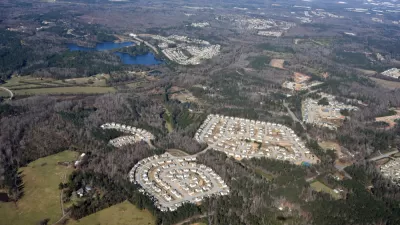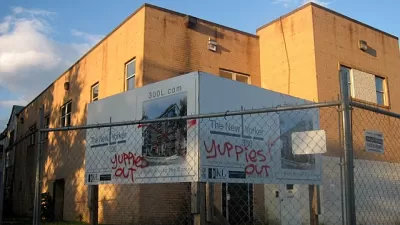Is the challenge of retrofitting sprawl intractable or unavoidable?

Robert Steuteville picks up on a debate from the CNU conference earlier this year about whether "whether sprawl repair is worth the trouble." Steuteville notes first that the debate was surprising, given that "Retrofitting Suburbia was one of top books in the planning field in the last decade" and co-author Ellen Dunham-Jones "has accumulated a database of more than 1,200 suburban retrofit projects under construction or in planning."
Architect Kevin Klinkenberg and development expert Lee Sobel, however, dared to argue that sprawl repair is "a fool's errand." Klinkenberg even penned a blog post in May making this provocative argument: "Suburbia, or sprawl as we interchangeably call it, is all about bigness and mass production," meaning, "it's outside the DNA of walkable cities. Embracing sprawl retrofit is like saying we can transform fast food culture into healthy food."
Steuteville, however, rejects that premise, and proceeds to take on theanti-suburban retrofit arguments, one by one. Those arguments include:
- "Even when suburban retrofit projects are built, the urbanism is far from great." Steuteville's response is that "turning a lousy place into a decent one improves people's lives."
- "Existing urban places are plentiful, so just work in those areas." Actually, argues Steuteville, the supply of urban areas with 19th century and early 20th century street grids is extremely finite, meaning it will never meet demand. "Values will relentlessly increase unless we transform some of the drivable suburban areas."
A final point is that much of what Klinkenberg abhors about sprawl, especially its "bigness," can also be found in cities. So, says Steuteville: "We can't avoid the task of sprawl repair—not even in cities."
FULL STORY: Sprawl repair is essential, unavoidable

Alabama: Trump Terminates Settlements for Black Communities Harmed By Raw Sewage
Trump deemed the landmark civil rights agreement “illegal DEI and environmental justice policy.”

Planetizen Federal Action Tracker
A weekly monitor of how Trump’s orders and actions are impacting planners and planning in America.

The 120 Year Old Tiny Home Villages That Sheltered San Francisco’s Earthquake Refugees
More than a century ago, San Francisco mobilized to house thousands of residents displaced by the 1906 earthquake. Could their strategy offer a model for the present?

Ken Jennings Launches Transit Web Series
The Jeopardy champ wants you to ride public transit.

BLM To Rescind Public Lands Rule
The change will downgrade conservation, once again putting federal land at risk for mining and other extractive uses.

Indy Neighborhood Group Builds Temporary Multi-Use Path
Community members, aided in part by funding from the city, repurposed a vehicle lane to create a protected bike and pedestrian path for the summer season.
Urban Design for Planners 1: Software Tools
This six-course series explores essential urban design concepts using open source software and equips planners with the tools they need to participate fully in the urban design process.
Planning for Universal Design
Learn the tools for implementing Universal Design in planning regulations.
Clanton & Associates, Inc.
Jessamine County Fiscal Court
Institute for Housing and Urban Development Studies (IHS)
City of Grandview
Harvard GSD Executive Education
Toledo-Lucas County Plan Commissions
Salt Lake City
NYU Wagner Graduate School of Public Service





























